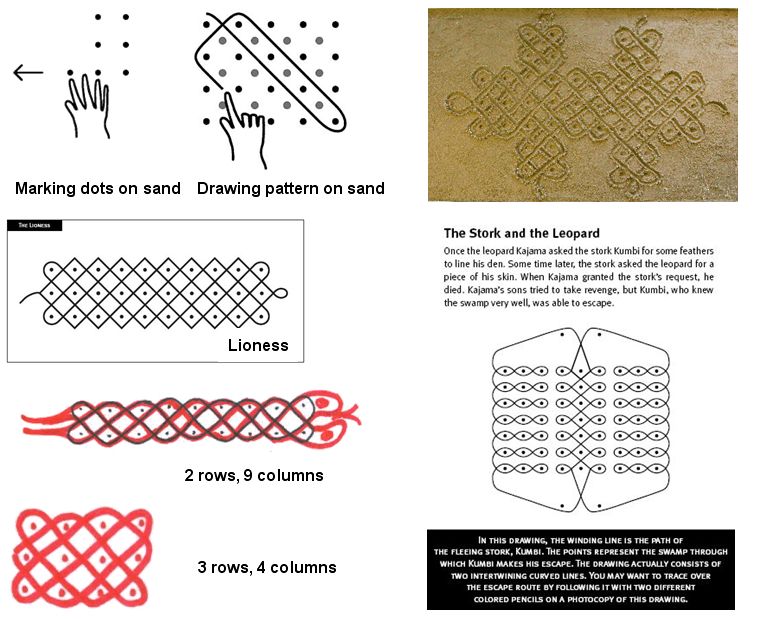Sona - Sand drawings of Angola
Normally, we in India arrange the dots for rangOlis using either the white rangOli powder or the wet rice flour. There is one more way of doing this. One can use the medium of sand and the dots can be arranged on the sand with fingers. Try this at home or when you go the beach. This is the method followed by some tribes in Angola. Angola, a former Portuguese colony, is in western Africa. They use their index and ring fingers to arrange the dots (see figure). After a certain number of rows are arranged, they continue this process to obtain the desired number of rows and columns. The uniformity is maintained because they use the same fingers throughout. Afterward, they use the index finger to draw the pattern. The most important point here is that they must not lift the finger and the pattern should be one single continuous line. They associate stories and myths as well as actual events to these drawings. Thus these drawings represent their oral history. The UNESCO is engaged in preserving this rich historical tradition. Unfortunately, it is slowly vanishing, it seems. Scientific papers in peer reviewed journals have been written on these sona (lisouna is the singular word) drawings. These are similar to our chikku kOlams. One important point from these studies is - if the numbers of rows and columns are relatively prime (that means the number of rows and the number of columns do not have a common divisor), then one will always get one single continuous line. It seems even a little boy would tell you by looking at the dot pattern whether you will get a single line or not. Do our friends have that type of intuition? I beg the experts on chikku kOlam to enlighten me. I have drawn two rangOlis to demonstrate this principle - the first one has three rows and four columns (the numbers 3 and 4 do not have a common divisor) and the second one has two rows and nine columns. In the second one, the single line is indicated in black. The red line indicates the same with extensions to represent a snake. What struck me was the association of stories with rangOlis. Do we have such stories in India except rare ones like the gOpadma I wrote a few days ago. It is time to think about this activity too.
Regards! - mOhana


Comments
lakshmiraghu
Tue, 2009-07-21 21:13
Permalink
mOhanaji You have taken to chindhood days.. just rembered I used draw like this after the rain stops near my house with my friends we use to keep a small stick and draw so that I need not get beating at the house ( if hands become dirty we use to have sweet beating )its was on the mud not sand. Now that you have shown we drive to marina beach to draw like this.... Thank you for taking me to childhood days.
Lata
Thu, 2009-07-23 13:03
Permalink
mOhanaji,
I've posted my response to this post in my blog. Since my comment contains a picture, I didn't know how you'll feel about me posting an image in your blog, and so I've posted my response in my blog.
http://www.ikolam.com/node/6528
Thank you.